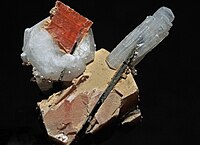
Photo from wikipedia
Barite (BaSO4) is a common additive in lead-acid batteries, where it acts as a nucleating agent to promote the reversible formation and dissolution of PbSO4 during battery cycling. However, little… Click to show full abstract
Barite (BaSO4) is a common additive in lead-acid batteries, where it acts as a nucleating agent to promote the reversible formation and dissolution of PbSO4 during battery cycling. However, little is known about the molecular-scale mechanisms that control the nucleation and cyclic evolution of PbSO4 over a battery's lifetime. In this study, we explore the responses of a barite (001) surface to cycles of high and low lead concentrations in 100 mM sulfuric acid solution using in situ atomic force microscopy and high-resolution X-ray reflectivity. We find that PbSO4 epitaxial films readily nucleate on the barite surface, even from solutions that are undersaturated relative to bulk PbSO4. Despite this, barite (001) proves to be an ineffective nucleator of bulk PbSO4, as multilayer growth is suppressed even in highly supersaturated solutions. Instead, we find evidence that Pb2+ ions can directly exchange with Ba2+ to create mixed (Ba,Pb)SO4 surfaces. These chemically mixed surfaces do not host PbSO4 monolayers as readily as pristine barite, and the original reactivity is not regained until a fresh surface is re-established by aggressive etching. Our results can be partly explained by traditional models of thin-film growth, which predict a Stranski-Krastanov (S-K) growth mode, where monolayer films are stabilized by a reduction in surface energy, but multilayer growth is inhibited by epitaxial strain. Complementary density functional theory calculations confirm the basic energetic terms of the model but also show evidence for thickness-dependent energetics that are more complex than would be predicted from traditional models. The experimental results are better understood by extending the model to consider the formation of mixed surfaces and films, which have reduced strain and interfacial energies relative to pure films while also being stabilized by entropy of mixing. These insights into nonstoichiometric heteroepitaxy will enable better predictions of how barite affects PbSO4 nucleation in battery environments.
Journal Title: ACS applied materials & interfaces
Year Published: 2023
Link to full text (if available)
Share on Social Media: Sign Up to like & get
recommendations!